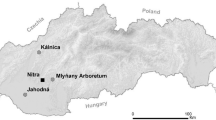Abstract
The needle rust of Korean pine is a common disease in the forest region in Yichun of Heilongjiang Province. It mainly harms the needles of young trees which are under the age of fifteen. The pathogenic fungus is identified asColeosporium saussureae Th ü m. Needle rust doesn’t cause pine trees to die, but reduces the growth rate of young trees. Pathogen requires an alternate host to complete its life cycle. The spermatia and aeciospores of pathogen live on the needle ofPinus koraiensis Sieb et Zuce. The urediospores and teliospores live on the back ofSaussureaes leaves. The basidiospores produced from dangniam teliospores are primary infection sources for Korean pine. The spreading period in woods for aeciospore is from the middle of May to the middle of June. The climax of the spreading period is the first ten days period of June. The temperature available for germ of various spores is as follows: aeciospores 10–27 °C, the optimum temperature 25 °C; urediospores 20–30 °C, the optimum temperature 22 °C; basidiospores 10–25 °C, the optimum temperature 20 °C. The early spring is an opportune to prevent and cure the disease.
Similar content being viewed by others
References
1979, 408–418
1980, No.3
1981, No.7
Author information
Authors and Affiliations
Rights and permissions
About this article
Cite this article
Yuhai, G. Study on Korean pine needle rust. J. Northeast For. Univ. 7, 36–40 (1996). https://doi.org/10.1007/BF02843053
Issue Date:
DOI: https://doi.org/10.1007/BF02843053




